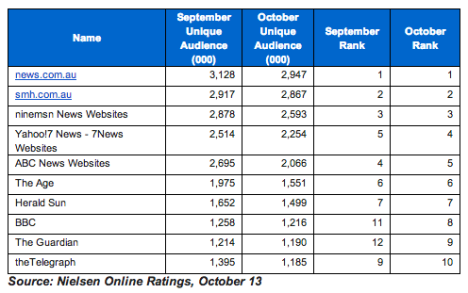The Guardian re-enters the top 10 Australian news websites
 UK newspaper The Guardian has re-entered the top 10 Australian news websites, amid an overall fall in online traffic last month after September’s election driven peak.
UK newspaper The Guardian has re-entered the top 10 Australian news websites, amid an overall fall in online traffic last month after September’s election driven peak.
The Guardian was ranked ninth in the October Nielsen Online Ratings with an audience of 1.19m down from 1.214m the month before.
This is only the second time The Guardian has ranked in the top 10, the last time was in May around the time of its launch, and came after falls in online audience for The Australian (1.16m) and Bigpond (1.05m) last month.
News.com.au has again retained its placing top of the Nielsen Online Rankings, which measure the unique audience of the major news websites.


Well done The Guardian.
Hey Mumbrella,
It would be good to see something about whether agencies will be looking at ComScore or Nielsen now the ABAA has switched to the former.
Are any agencies willing to go on record about which stats they prefer / trust / use?
Apologies if I have missed prior coverage on the degradation of smh.com, news.com and others into click bait sites, but I wonder about the actual value of any measurement of punters visiting these sites for “news”. Seems to me I see most of the “news” items on time wasting websites based in the US several days before they pop up here on Australian news web sites…..
It never ceases to amaze me that publishers look at their internal website traffic data, and expect it to match the web-based audience data. Traffic always exceeds audience, and generally several orders of magnitude. By all means talk traffic within your own four walls, but when you’re out there trying to see to us media agency people talk audience.
And GM … doubt it. Cheese and chalk apart.
Know the smh and news.com.au folk are chucking everything at this, interesting result.
Meanwhile, check out the Faily Telegraph. NEWS’ CEO has been talking about the importance of the switch to digital, but they’ve sure got a lot of work to do. Their content just doesn’t work for the internet. I mean, who would log onto the Telegraph website if they were looking for the latest news?
I think it’s fair enough to point out discrepancies between web traffic with audience data without comparing apples with pears. You can compare consistency of growth between metrics. The problem with all panel based methodologies is that medium to small publishers data can fluctuate wildly; and also unless the panel is extremely well constructed and constantly reviewed (they rarely are) the data can be just plain misleading.
SeaDog you make a good point about panel based methodologies (when used solus). At a market-level, panels tend to understate audience by around 25%. On the flip-side server/tag-based measurement tends to overstate audience by a factor of 3x to 5x. The fact is … neither are right, and that one is more misleading than the other. It is also a simple matter with a few lines of code to “pump up” traffic data with no change in the real-world audience – i.e. they do not always trend together (though it is often assumed that they should – just like people assume circulation and readership should, but don’t have to).
The direction that the IAB is heading in using BOTH tagged traffic AND panel data seems (at the moment) the most fruitful as it reduces the reliance on the panel while leveraging the traffic data.
Having said that, it is STILL extremely difficult to produce reliable audience estimates for sites that have small audiences even though they appear to have large traffic volumes. One has to think that if you a panel of 8,000 people and in one month 8 people visit a site, then the next month 16 people use the site within a month … that whether it is 1 in a thousand or 2 in a thousand (i.e. a 100% variance) then given that incidence, the audience is still liable to be pretty small in the grand scheme of things. For such sites there are probably better ways to sell their inventory.